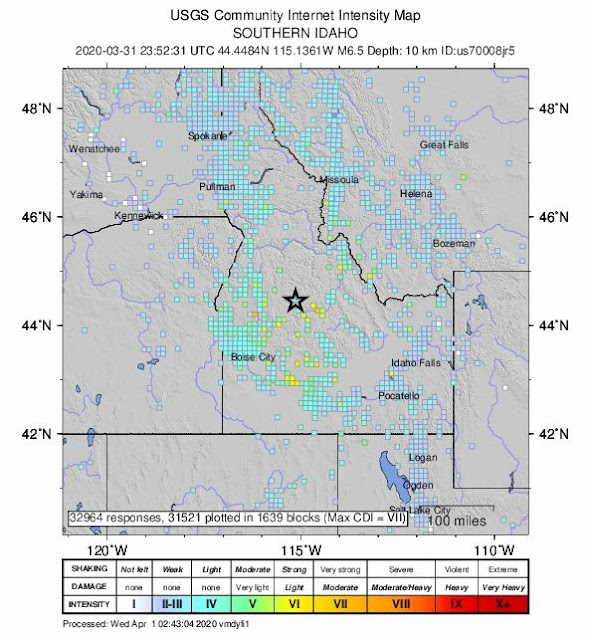M6.5 Stanley, Idaho Earthquake
M6.5 Stanley, Idaho Earthquake
March 31, 2020
See where, why, and what happened in this unusual Idaho earthquake
Geology of the Quake
6.5 is a pretty big earthquake! Seismologists officially call it "moderate," but that's because they compare it to the whole world. In Idaho, this is a big one! Only the M6.9 Borah Peak quake in 1983 was bigger in the past century.
It was felt from northern Utah and Nevada, throughout Idaho to western Montana and southern Canada.
The location's the thing. It happened just at the boundary between the extending tectonic province called the Basin and Range and the less-stressed province of the Pacific Northwest. The crust in the Basin and Range is being pulled (extended) westward, while the Pacific Northwest here is experiencing very little stress. The direction the fault slipped doesn't really match either block -- a north-south trending left-slip fault (opposite of the San Andreas, which is right-slip). In simpler terms, left-slip means when looking across the fault, the other side moved to your left.
The epicenter was NW of Stanley, out in the mountains of central Idaho. According to this geologic map from the USGS, the local area has several candidate faults at the surface which could have caused the quake. The bedrock there is mostly granite (green on this map). This map also shows where Stanley and Stanley lake are relative to the epicenter.
I went to the road closure, which is a permanent gate in case of avalanches. I couldn't get close enough to the snow slides to see them.
The road up the Beaver Creek canyon at the epicenter was blocked by snow, but this hillside had some rocks fallen onto the snow.
After the snow cover melted away, I went back to Stanley. This is the amazing view of the Sawtooth Mountains from Galena Summit. Stanley is at the far right in this valley, and the epicenter just past the Sawtooths in this view.
These eye-popping glaciated granite mountains are why Stanley is popular. Many aftershocks occurred under these peaks.
Stanley Lake
The largest and most visible damage from the quake was subsidence of the west shore of Stanley Lake, shown here. These trees are now sitting in a foot of water.The inlet delta from the creek (inventively named Stanley Lake Creek) liquefied during the quake and sank into the lake. There used to be a quite large sandy beach here. Now the forest is sunk into the lake!
A closer view of the sunken shoreline. Notice the tilted and fallen trees. During liquefaction, the soil flows, removing support from tree roots.
Liquefied soil has no strength, and so cannot support trees. Fallen or tilted trees are a sign of liquefaction.
From along the lake, you can see the sunken and tilted trees on the western show in front of McGown Peak.

Here's a little closer view of the sunken shoreline.
In summary, the M6.5 quake near Stanley, Idaho was one of the biggest in the region in the past century. Because of its location, however, it did no structural damage, but only damage to vulnerable soils and slopes. Its location at the boundary between tectonic provinces means it will be studied by geologists for years to come, in the quest to better understand the earth in this fascinating region.























